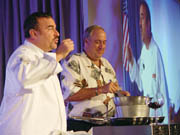
The 22nd annual New Products Conference, sponsored by Prepared Foods, brought together the developers and decision makers behind new product development in the food and beverage industry. Nearly 300 attendees bore witness to a series of seminars and networking events specifically designed to encourage and educate. Despite the allure of the Fairmont Princess Resort facilities, attendees were eager and willing to explore a full range of industry topics, ranging from the cutting-edge to the adventurous to the future.
Indeed, those possibilities were at the fore during the three-day conference. From the very outset, speakers strove to push the boundaries of R&D thinking, and such a mentality was at the very heart of the conference's keynote speech. Ruth DeBusk, principal with Interactive Training Media (Tallahassee, Fla.), certainly delivered with “Advancing Genomics: What it Means for New Food Product Development,” which addressed foods' potential as medicines of the future.
As consumers become more aware of their genetic makeup through genomics, they will seek foods more appropriate for their health, DeBusk believes. Genetic technology will enable self-directed healthcare of a sort, resulting in a demand for foods tailored to specific health risks identified by genetic testing. If and when this comes to pass, the mindset of consumers may well change: they now tend to contemplate negatives (cancer, high blood pressure, etc.); a genetics-influenced future could see them more concerned about the specific health positives of foods.
Nutritional genomics (nutrigenomics) will integrate genetic technology into food and nutrition science, resulting in a consumer base with a clear knowledge of which foods will offer a greater healthful benefit. DeBusk foresees the day when consumers are tested to discover their genetic profile, their genotype, which defines what a person can be. The genotype is augmented by a person's environment (which includes food consumed) to determine what a person ultimately will be.
Lifestyle choices based upon these factors can help individuals realize how to maximize their potential and minimize their respective risks. Dietary approaches in this regard will include overall diet, functional foods and nutritional supplements.
This technology is still some time away. Nonetheless, DeBusk warns companies that the one-size-fits-all approach to health will have to give way to diets customized to one's genotype. In this environment, she predicts the need for three types of food:
1. Existing items known to have components that promote health.
2. Common foods that can have health components added.
3. Designing and developing new products with specific health components.
Such big goals were at the heart of advice offered during “Innovation and Product Development” by Ricky Singh, director R&D, Schwan Food Company (Minneapolis). He identified the drivers of innovation within food and beverage companies: big goals; visionary leadership; missions and values; available expertise; innovation processes; an innovative culture; and adequate resources. Less-appreciated among the factors driving innovators are the ability to manage people, not projects; creation and management of chaos; and celebrating small victories.
In the process, Singh offered a unique piece of advice: “If at least two departments don't feel uncomfortable about the product, it's probably not too innovative.”

Beverages' Better Days
Perhaps suffering from a lack of such innovation, the beverage category has endured a lackluster year and a particularly disappointing summer, opined Gary Hemphill, with Beverage Marketing Corporation (New York). The year has seen higher prices, especially on carbonated soft drinks and beer, not to mention weak results on new innovation.While the category as a whole has disappointed, growth can be found, albeit in the smaller segments. Enhanced water, for instance, is led by Propel (Gatorade, PepsiCo, Purchase, N.Y.), although Glaceau (Energy Brands Inc., Whitestone, N.Y.) holds a notable 20% of the segment. Gatorade, on the other hand, has a stranglehold on the $3 billion sports drink segment, accounting for 82%, followed distantly by Powerade's (Coca-Cola, Atlanta) 14% share.
As Hemphill notes, the success of these two segments points to a trend that, though not unique to the beverage segment, has a huge role. Functional beverages are on the horizon and, indeed, have begun to arrive, considering the recent launch of 7Up Plus (Dr Pepper/7Up, Plano, Texas). By 2010, expect an even greater emphasis on “real” health benefits; fortified waters and energy drinks; kid-targeted water, juice and milk drinks; and liquid meal replacements. Plus, the category also will benefit from packaging innovation: continued size and format proliferation; more functional and interactive packages; and packages that target specific segments such as kids, seniors and teens.
In addition, Hemphill identified several keys to future success in the beverage category:
Convenience and the need for saving time is not unique to products geared to adults, either, related Bryan Urbick, director of research with the Consumer-Knowledge Centre (Edgware, U.K.). Foods need to fit into the busy lives of young people and, Urbick warned, convenience is a cost of entry into children's food offerings, not a trend.
In addition, Urbick identified the paradox companies face when tailoring products for children: to this group, old is boring, yet new is scary; they are young but savvy. They tend to revert to familiar flavors, food forms and brands; Urbick believes sampling needs to be a huge aspect of a new product launch.
In challenging that aforementioned paradox, companies were warned not to change the food form, flavor and pack all at once. However, perhaps the most important advice about communicating with children is: they change dramatically, even from one year to the next, and companies should speak to them as if they are two to three years older than they actually are.
Reg Dawn
Addressing one of the key health topics addressed by the FDA in recent years, Steven Steinborn's “Regulatory Update: Must-know Information for Product Developers” began by exploring trans fat challenges. Steinborn, partner with Hogan & Hartson LLP (Washington), warned that mandatory labeling of the ingredient is only 13 months away (January 2006), and manufacturers are under significant pressure to reformulate.A somewhat confusing aspect of the labeling issue stems from the fact that “trans fat-free” is an unauthorized claim, yet “0g trans fat” is probably allowable, Steinborn surmises. For that matter, the question of 0g may come into question. The FDA regulates that anything less than 0.5g is considered 0g. However, the possibility exists that consumers could enjoy multiple servings of 0g products and have a cumulative intake in excess of the RDA of 2g trans fat. As a result, Steinborn suggests the day will come when 0g may mean 0.2g or less, but he further notes that this likely will not happen anytime soon.
Qualified health claims also drew Steinborn's attention, as certain of these have been of interest to the FDA of late. The claims allow companies to communicate certain aspects of diets with health benefits, if it can be sufficiently proven. He advises companies to pay attention to the Federal Register for competing products in particular, and to voice concerns to any such claims during the review period. Petitioning the FDA to modify its decision to allow a qualified health claim can be a challenge, so he advised it would be best to address such situations during the FDA's comment time.
Transformers
Valerie Skala Walker, with Information Resources Inc. (Chicago), unveiled “Transformational New Products,” which she defined as big-sellers (accounting for over $50 million in year-one sales), and those that build a category. The low-carb trend of recent years has inspired a number of companies, as the phenomenon officially went mainstream in 2003, meaning it hit 10% household penetration in the U.S. By mid-2004, such products had accounted for over $1 billion in sales. With such a strong entry in the obesity fight, one would be hard-pressed to identify the other trends making headway, but Skala Walker observed that soy, natural/organic and new nutrients (glucosamine, lutein, etc.) are among the health trends to watch.
Furthermore, products will experience additional reductions in sugar and nutritional enhancements. In fact, sugar-free introductions are growing faster than the rest of a variety of categories, including gum, candy and carbonated soft drinks, she said.
In their annual Global New Products Presentation, Lynn Dornblaser and David Jago, directors with Mintel's Global New Products Database (GNPD, Chicago), concurred with Skala Walker on the popularity of the health/wellness trend. As the pair noted, however, that trend is manifesting itself in the form of lowered carbohydrates only in the U.S. Nonetheless, health and wellness introductions do represent the single largest area of new product activity, although many are adding positive attributes rather than subtracting undesired elements such as sugar, carbs, etc. Interestingly, while that low-carb effort has not taken off globally, a number of areas (including Australia and Japan) have borne witness to the popularity of consumer interest in products' glycemic indexes.
Introductions around the globe are tackling trends similar to those of the U.S., with convenience and wellness being two of the most popular. However, Dornblaser did offer a significant observation: major trends do not change much over time, but cutting-edge approaches often emerge abroad, which suggests that U.S. manufacturers should widen their focus and possibly even look outside the food and drink category.
Turning the audience's attention to the foodservice side of the industry, Brian Averna, corporate executive chef with Sara Lee Foods (Cincinnati), presented “Perspectives on the Future of Foodservice.” Averna informed attendees of Americans' growing regard for authentic foreign cuisines, not just Americanized versions. Americanized Italian foods, for example, are far different from their sources, but companies are realizing that well-traveled Americans want authentic cuisine. With that in mind, American chefs are discovering and implementing delicacies from other areas of the Mediterranean—Morocco, Turkey, even various areas within Italy.
Such a diversity of topics permeated the conference's seminars and even the networking opportunities available during the three days in Arizona. All of which left attendees with new ideas, fresh approaches and important lessons to ponder in their own R&D practices.
Next year's New Products Conference will be held October 16-19 at the Ritz-Carlton Naples in Naples, Fla. For more information, contact Marge Whalen at 630-694-4347, e-mail whalenm@bnpmedia.com or visit Prepared Foods' website: www.PreparedFoods.com.

Top Issues Impacting R&D
The featured panel at this year's New Products Conference saw executives from three of the industry's largest companies offering insight into major trends and challenges on the horizon.Todd Abraham, vice president of R&D with Kraft Foods (Glenview, Ill.):
1. Convenience: The number of hours worked per week is increasing worldwide.
2. Small-company impact: Industrial R&D is on the rise among smaller companies (with less than 1,000 employees), while declining among companies with more than 25,000 employees.
3. Globalization: E-work and video/teleconferencing have led to major food development on all continents.
4. Changing demographics: A population shift is occurring on several fronts in America. In the U.S., the number of Hispanic households continues to rise. However, an increased aging population is not unique to the U.S.: by 2020, Western Europe will see a 35% rise in the number of those over the age of 60, while numbers in Eastern Europe will increase 31%.
5. Health/wellness: Obesity is a worldwide problem, yet most consumers fail to get enough calcium and fiber.
Leah Evans, senior vice president of R&D and chief food innovation officer with Pizza Hut (Dallas):
1. Sustainability: The goal of sustainability is to meet present needs without compromising future generations. Triple-bottom-line economics has to answer whether a company's decision is good for business, for people and for the planet. While not a widespread trend at present, sustainability efforts are underway in a number of companies, and these firms have lowered their usage of energy and water and dropped waste production, while increasing productivity and profits.
2. Healthy living: Some 95% of consumers view obesity as a health problem, and companies are responding in a number of ways: choices, more information and portion control.
3. Authenticity: Consumers are beginning to appreciate authentic ingredients, methods, visuals, aromas, sources, brand images, etc.
4. Confidence & safety: Fear of the safety of the food supply has resulted in an opportunity to deliver confidence through processing (preservation technology), endorsements (as seen in the Atkins branding at TGI Fridays, Carrollton, Texas) and origin (the source of the food).
5. Boom-boom power: The U.S. has 78 million Baby Boomers; their children, the Echo Boom generation, number 73 million. Some 32 million of the resulting Boom-boom households have children under the age of 18.
Neil Willcocks, director of R&D with Masterfoods USA's Petcare North America, a division of Mars Inc. (Hackettstown, N.J.):
1. Customization: Good design is not about creating the perfect thing, but about presenting items that individuals can tailor-make to become their perfect things.
2. Trading up: An investment in products promising more but not priced out of reach.
3. Health: Healthier choices are becoming more the norm in the fast-casual segment and are finding their way to fast food environs as well, though at a slightly higher price.
4. Design: Three elements combine to comprise the consumer's regard for the product: 1. visceral, the first impression, 2. behavioral (did the product work as promised/suggested?) and 3. reflective (would the consumer buy the product again?).
5. Conscience: In a trend similar to the one proffered as “sustainability” by Evans, Willcocks believes future consumers are apt to appreciate values rather than value. Such conscience-minded decisions will allow businesses to become a positive source of change, change which will be to the advantage of future generations.
